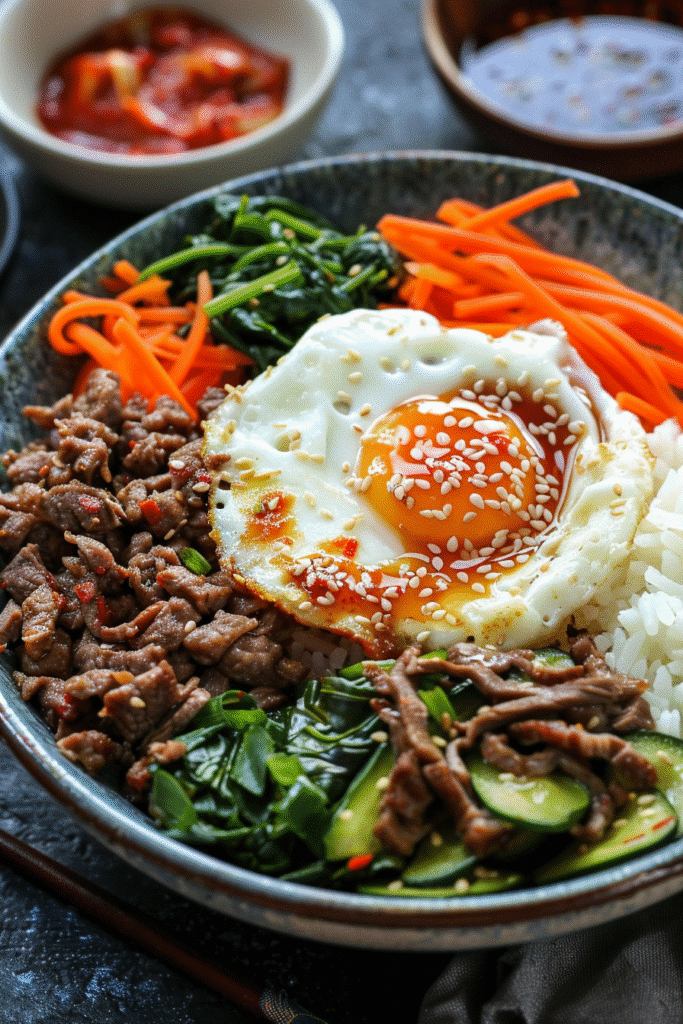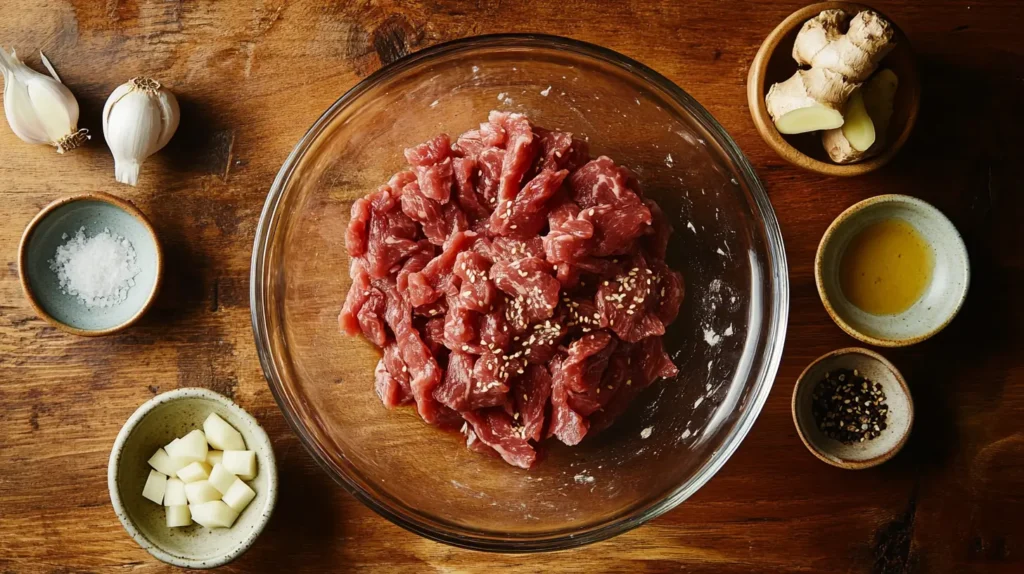
Bulgogi Bibimbap Recipe: A Quick & Flavorful Family Favorite
Table of Contents
Growing up near a serene water dam, my grandmother’s kitchen was the heart of our home. She taught me that every dish tells a story, and Bibimbap is no exception. This vibrant Korean rice bowl, topped with marinated beef and assorted vegetables, embodies the harmony of flavors and textures a perfect metaphor for family unity.
Why You’ll Love This Bulgogi Bibimbap Recipe
- Quick & Easy: Ready in under 30 minutes, making it ideal for weeknights.
- Nutritious: Packed with protein, vegetables, and wholesome grains.
- Customizable: Adaptable to various dietary needs and preferences.
- Family-Friendly: A fun way to involve kids in meal preparation.
Ingredients For Bulgogi Bibimbap Recipe

For the Bulgogi (Marinated Beef)
- 500g thinly sliced beef (ribeye or sirloin)
- 1/4 cup soy sauce
- 2 tablespoons brown sugar
- 1 tablespoon sesame oil
- 2 cloves garlic, minced
- 1 teaspoon grated ginger
- 1/2 pear, grated (for tenderizing)
- 1/4 teaspoon black pepper
For the Bibimbap Sauce
- 2 tablespoons gochujang (Korean red chili paste)
- 1 tablespoon sesame oil
- 1 tablespoon sugar
- 1 tablespoon water
- 1 teaspoon vinegar (apple cider or rice vinegar)
- 1 teaspoon minced garlic
For the Vegetables
- 2 cups spinach
- 1 cup bean sprouts
- 1 medium carrot, julienned
- 1 zucchini, julienned
- 1 cup mushrooms, sliced
- 1 cucumber, thinly sliced
- 2 teaspoons sesame oil
- Salt to taste
Additional Components For Bulgogi Bibimbap Recipe
- 4 cups cooked rice (white or brown)
- 4 eggs
- Sesame seeds for garnish
- Nori (seaweed) strips for garnish (optional)
Instructions
1. Marinate the Beef
In a bowl, combine soy sauce, brown sugar, sesame oil, minced garlic, grated ginger, grated pear, and black pepper. Add the thinly sliced beef, ensuring it’s well-coated. Let it marinate for at least 15 minutes.
2. Prepare the Bibimbap Sauce
Mix gochujang, sesame oil, sugar, water, vinegar, and minced garlic in a small bowl until smooth. Set aside.
3. Cook the Vegetables
- Spinach: Blanch in boiling water for 1 minute, then drain and squeeze out excess water. Season with a pinch of salt and a few drops of sesame oil.
- Bean Sprouts: Blanch for 2 minutes, drain, and season similarly to spinach.
- Carrot & Zucchini: Sauté separately in a pan with a little sesame oil and salt until tender.
- Mushrooms: Sauté with a bit of sesame oil and salt until cooked through.
- Cucumber: Serve raw for a refreshing crunch.
4. Cook the Bulgogi
In a hot pan, cook the marinated beef until it’s fully cooked and slightly caramelized. This should take about 5-7 minutes.
5. Fry the Eggs
Fry the eggs sunny-side up, ensuring the yolks remain runny for that authentic Bibimbap experience.
6. Assemble the Bowls
In each bowl, place a serving of rice at the bottom. Arrange the cooked vegetables and bulgogi on top in sections. Place the fried egg in the center. Drizzle with Bibimbap sauce and garnish with sesame seeds and nori strips if desired.
Tips for Success
- Make-Ahead: Prepare the vegetables and marinate the beef in advance to save time.
- Vegetarian Option: Substitute beef with tofu or mushrooms.
- Spice Level: Adjust the amount of gochujang in the sauce to suit your heat preference.
Nutritional Information (Per Serving)
| Component | Amount |
|---|---|
| Calories | 550 |
| Protein | 30g |
| Carbohydrates | 60g |
| Fat | 20g |
| Fiber | 5g |
Easy Bulgogi Bibimbap
Equipment
- Mixing bowl
- Skillet
- Saucepan
- Frying Pan
Ingredients
Bulgogi (Marinated Beef)
- 500 g thinly sliced beef (ribeye or sirloin)
- 1/4 cup soy sauce
- 2 tbsp brown sugar
- 1 tbsp sesame oil
- 2 cloves garlic minced
- 1 tsp grated ginger
- 1/2 pear grated
- 1/4 tsp black pepper
Bibimbap Sauce
- 2 tbsp gochujang Korean red chili paste
- 1 tbsp sesame oil
- 1 tbsp sugar
- 1 tbsp water
- 1 tsp vinegar apple cider or rice vinegar
- 1 tsp minced garlic
Vegetables
- 2 cups spinach
- 1 cup bean sprouts
- 1 carrot julienned
- 1 zucchini julienned
- 1 cup mushrooms sliced
- 1 cucumber thinly sliced
- 2 tsp sesame oil for sautéing vegetables
- salt to taste
Additional Components
- 4 cups cooked rice white or brown
- 4 eggs
- sesame seeds for garnish
- nori strips optional, for garnish
Instructions
- Marinate the Beef: Mix soy sauce, brown sugar, sesame oil, garlic, ginger, pear, and black pepper. Add beef and marinate for 15 minutes.
- Prepare Bibimbap Sauce: Stir gochujang, sesame oil, sugar, water, vinegar, and garlic until smooth. Set aside.
- Cook Vegetables: Blanch spinach and bean sprouts. Sauté carrot, zucchini, and mushrooms. Keep cucumber raw. Season all lightly with sesame oil and salt.
- Cook Bulgogi: Sauté marinated beef in a hot skillet for 5–7 minutes until caramelized.
- Fry Eggs: Fry eggs sunny-side up, keeping yolks runny.
- Assemble: Add rice to bowls. Top with vegetables, bulgogi, and egg. Drizzle sauce and garnish with sesame seeds and nori.
Notes
Frequently Asked Questions (FAQ): Bulgogi Bibimbap Recipe
Can I use chicken or pork instead of beef for bulgogi?
Absolutely! Thinly sliced chicken thighs or pork shoulder also work beautifully with the bulgogi marinade. Just be sure to adjust cooking times accordingly chicken should be fully cooked through, and pork benefits from a slight char.
Is Bibimbap traditionally gluten-free?
Not always. Soy sauce often contains gluten, so for a gluten-free version, swap in tamari or a certified gluten-free soy sauce. Always double-check your gochujang too some brands add wheat.
What’s the best rice to use for Bibimbap?
Short-grain white rice is most traditional, but brown rice, jasmine, or even cauliflower rice for a low-carb option are all great. The key is using rice with enough stickiness to hold the bowl together.
Can I prepare Bibimbap ahead of time?
Yes! You can pre-cook all the components and store them separately in the fridge. Assemble and reheat just before serving for a quick, fresh-tasting meal.
What can I substitute for gochujang?
If you can’t find gochujang, you can mix a combination of sriracha, miso paste, and a little honey as a quick alternative. It won’t be identical, but it’ll still bring that sweet-spicy-umami punch.
How do I involve kids in making Bibimbap?
Let them help arrange the veggies, spoon the rice, or drizzle the sauce it’s like a rice bowl art project! Bibimbap is perfect for picky eaters since they can customize their bowl.

Conclusion: A Spedy Bowl of Joy
There’s something magical about a meal where everyone builds their own bowl laughing, layering, and sneaking tastes along the way. That’s why Bulgogi Bibimbap is more than just a dish it’s a celebration. A beautiful balance of flavors, textures, and colors that’s as nourishing to the soul as it is to the body.
For me, it’s a bridge between cultures and generations. It’s Grandma’s wisdom in choosing whole foods, my own twist in speeding things up, and my kids’ delight as they craft their own “masterpiece bowls.”
So whether you’re prepping for a weekday dinner, looking for something vibrant to share with friends, or simply craving a comforting bowl of flavor, this Bulgogi Bibimbap Recipe is a surefire way to bring smiles to your table fast.
💬 What’s Your Favorite Bibimbap Twist?
Did you add avocado? Go veggie? Use quinoa instead of rice? Share your version in the comments or tag @SpedyRecipes on Instagram with your bibimbap bowl! I’d love to feature your creativity in our next #SpedyFamilyKitchen round-up.
Share Your Creation!
I’d love to see your Bulgogi Bibimbap masterpieces! Share your photos and tag @SpedyRecipes on social media. Let’s celebrate the joy of cooking together!
Love bold bowls? Follow me for more easy, comforting meals packed with flavor!

